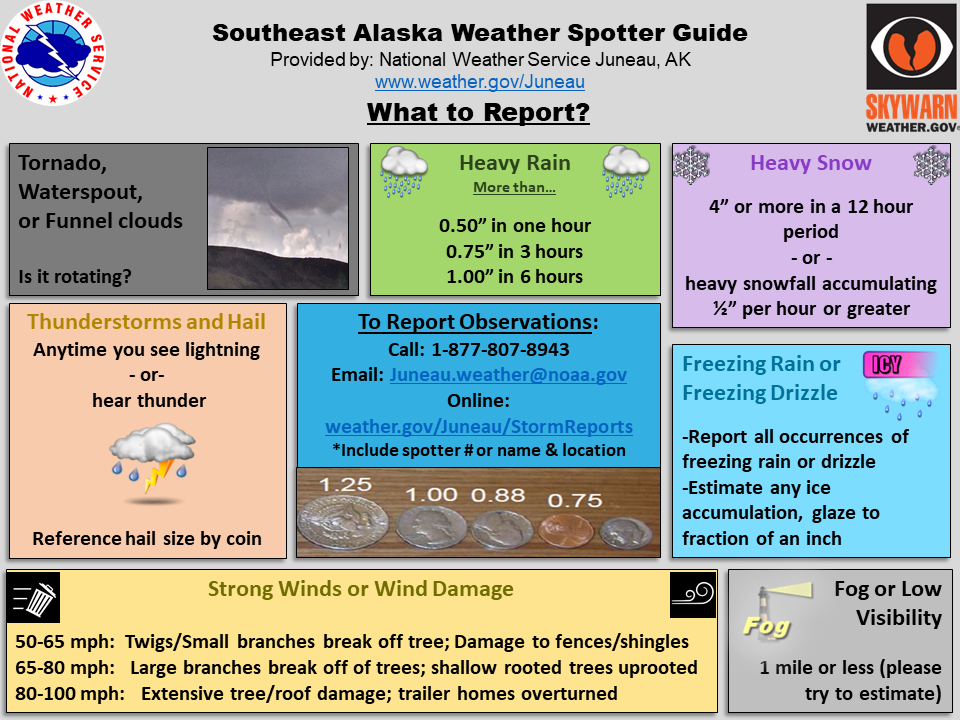
Volunteer weather spotters are able to help their community and surrounding communities by reporting significant weather to the NWS. A weather spotter provides reports to us by phone, internet, email, or social media. There may be times where we will call you in the event that something unexpected is happening in your area or to ask further questions on a report that you already gave to us.
To become an official NWS spotter, take our free online training or attend an in-person training, which can be coordinated for your group. In person training sessions are held a few times per year and announced on this page and on social media. The spotter training covers how to make and send a spotter report, and provides spotters with a common "weather language" to identify and describe different weather events. It is important that each spotter describes the same weather in the same way. This allows the NWS to incorporate your reports directly into their forecasting and warning system.
The online training consists of reviewing the posted training materials and filling out a sign-up form. The in-person training is a one hour presentation, with additional time for questions. It is recommended to review the training every two years.
What happens after I fill out the spotter signup form? We will contact you via phone or email with your official Spotter Number based on where you live.
Additional Information:
**If you move away or no longer wish to be a spotter, please let us know by phone or email and we will take you off our list.**
Reporting hazardous weather (all year) is essential! Remember that each report, regardless of the method, must include the time and location of the event.
When to report: Whenever you see weather that is, or potentially is, damaging or hazardous! Reporting when the forecast is off is also extremely helpful in locations with few automated stations.
Why spotter reports are important: The key element of the mission of the National Weather Service is to issue weather-related warnings for the protection of life and property. So, volunteer storm spotters help us achieve this goal by giving us the information on hazardous weather as it's occurring.
How To Submit A Report:
Website: Click the Storm Report tile under the map and hit Submit a Weather Report.
Email: juneau.weather@noaa.gov - A great way to share pictures and/or video with us!
Telephone: 1-877-807-8943 - Be sure to have your spotter number ready so that we can identify who you are!
Facebook: Visit the NWS Juneau Facebook page and post your weather report to our wall.
Twitter: Send Twitter reports to the National Weather Service by including the #akwx hashtag or send them directly to @NWSJuneau.
With any report, please include your Spotter # (for existing spotters only) or who you are (public, law enforcement, etc.), location, the time of the event, and what occurred.

|
|
|
|
|
|
|
|
|
|
|
|
|
|
|
|
|
2024 Spotter Training Schedule
Email nicole.ferrin@noaa.gov to suggest your community! |
Want to become a weather spotter but don't see your town listed?
You are welcome to review our training online and submit this form.
NWS Juneau storm spotters are critical eyes-on-the-ground volunteers who identify and report severe weather to the NWS. In Alaska, this mainly consists of reporting high winds, snowfall totals or the presence for freezing rain and ice accumulation. However, we encourage storm spotters to report any weather that is impacting their community.
Spotters provide verification of severe weather occurring in their area. Due to the limited radar coverage in Southeast Alaska, our spotter reports are often the only way of confirming what is going on at the surface. We use our spotter reports to aid in the forecasting and warning process to make sure we are putting out the most accurate and up-to-date forecasts and weather advisories as possible. We also use the reports to inform the public through the media of any significant weather.
You will not get paid to be a spotter. All of our spotters are volunteers.
No. It is not necessary to have weather instruments to be a spotter. Snowboards, snow sticks, and rain gauges are helpful when reporting snowfall and rainfall measurements.
Cooperative observers submit weather information such as temperature and precipitation on a daily basis, while spotters only report severe weather on an as-needed basis.
All information provided on the storm spotter registration form will never be released and remains internal to the NWS. All spotter reports received will only be identified by spotter ID.
If you move out of Southeast Alaska, we will remove your name from our storm spotter list and refer you to the nearest National Weather Service office at your new location. If you move, but remain within Southeast Alaska and still want to be a spotter, then contact us with your updated information.
Contact our office at Juneau.weather@noaa.gov